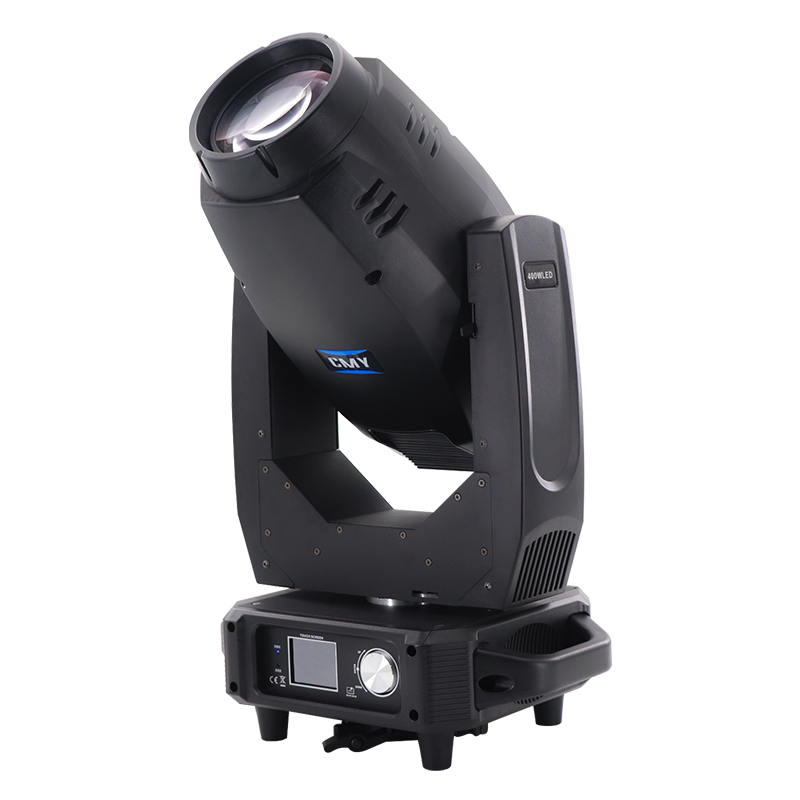Introduction: The Complexity Behind Modern Light Shows
Modern lighting systems are no longer just about turning lights on and off. Today’s productions require fixtures to behave like synchronized performers—responding to cues, matching musical rhythms, and adapting to complex sequences in real-time. One of the key technologies enabling this is Master/Slave mode, combined with multi-channel fixture programming.
Understanding how to configure your lights for synchronized group control, while still tapping into the full range of motion, color, and effects, can transform your stage setup. In this article, we’ll explore how to use these technologies effectively—with practical examples centered around the L-40 400W CMY LED 3-in-1 Moving Head Light.

1. What Is Master/Slave Mode?
1.1 Basic Definition
Master/Slave mode allows a group of lighting fixtures to follow the behavior of a lead (Master) unit. The Master sends control signals to all connected Slaves, ensuring they perform the same actions at the same time.
This setup is particularly useful for events where lighting needs to remain synchronized across multiple fixtures but without the need for a complex lighting console.
1.2 Typical Use Cases
Mobile DJs who want consistent movement and effects with minimal programming
Live bands with pre-defined scenes triggered by audio input
Fixed installations with synchronized light shows
The L-40 400W CMY LED 3-in-1 Moving Head Light is fully compatible with Master/Slave configurations. It supports auto-run programs that can be initiated on one Master unit and replicated across multiple Slave fixtures.
2. Benefits of Master/Slave Configuration
Using Master/Slave mode reduces setup complexity while maintaining a strong visual impact. Key benefits include:
Simplified wiring: Only one fixture needs to be connected to the controller.
Coordinated effects: Pan, tilt, color, and gobo effects stay in sync.
Quick deployment: Ideal for fast event setup or mobile gigs.
With the L-40 400W CMY LED 3-in-1 Moving Head Light, technicians can configure pre-programmed scenes using onboard menus, eliminating the need for external DMX control in basic shows.

3. Understanding Multi-Channel Control
3.1 What Is a Channel?
A DMX channel corresponds to a specific parameter in a fixture. For example, one channel might control pan movement, while another controls color or dimming. The more channels a fixture supports, the more granular control it offers.
3.2 Channel Modes in L-40
The L-40 400W CMY LED 3-in-1 Moving Head Light offers a 21-channel DMX mode, giving lighting designers full access to:
CMY color mixing
Pan (540°) and tilt (270°)
Zoom (7°–42°)
Gobos, prisms, and strobes
Dimming curves and movement macros
This deep control capability allows for both simple and complex scenes to be programmed, with each channel mapped to a console slider or automation cue.
4. Combining Master/Slave with Multi-Channel Precision
One of the most powerful approaches in live lighting is to use multi-channel programming on the Master fixture while others follow in Slave mode. Here’s how it works with the L-40 400W CMY LED 3-in-1 Moving Head Light:
Program the Master with a complex sequence using DMX or built-in macros
Assign all other L-40 units to Slave mode
Trigger the show via DMX or standalone auto-run
Because the L-40 400W CMY LED 3-in-1 Moving Head Light supports both RDM and DMX512, you can remotely adjust Slave fixture addresses, monitor responses, and tweak effects live—all without manually touching each fixture.
5. Real-World Application: Theater Setup
In a university drama production, four L-40 400W CMY LED 3-in-1 Moving Head Light units were used to provide mood transitions and spotlight effects. The lighting technician programmed the Master unit with a dynamic cue list—soft blue transitions, sharp amber fades, and spot gobos for monologues. The Slave units, suspended above the stage, mirrored every action in real time.
The result? A tightly synchronized light show that enhanced every act, with minimal need for manual control.
6. Common Pitfalls to Avoid
While Master/Slave mode and multi-channel DMX are powerful, improper setup can lead to issues:
6.1 Address Conflicts
Ensure that only the Master has the DMX address assigned. Slaves should not respond to external DMX unless in a hybrid setup.
6.2 Looping Errors
Don’t create a circular data loop by daisy-chaining a Slave back to the Master. This may cause signal errors.
6.3 Channel Overlap
Ensure channel mappings on your lighting console match the fixture’s manual. The L-40 400W CMY LED 3-in-1 Moving Head Light offers a clear DMX chart in its user guide, which should be referenced for exact channel functions.
7. Programming Tips with the L-40 400W CMY LED 3-in-1
7.1 Use Macros for Efficiency
Leverage built-in movement and color macros when time is limited. The L-40 400W CMY LED 3-in-1 Moving Head Light includes pre-configured effects that reduce programming effort.
7.2 Pan/Tilt Sync
Adjust movement speeds on channel 3 and 4 (Pan/Tilt Speed) to ensure smooth transitions across fixtures.
7.3 Scene Recall
Use your console or controller’s scene memory to call complex setups. The 21-channel layout allows precise shaping of beam and mood.
8. Advanced Setup: Multi-Zone Mapping
For larger venues or productions, break your rig into zones. Use one L-40 400W CMY LED 3-in-1 Moving Head Light as a Master for each zone:
Zone A: Upstage color transitions
Zone B: Midstage gobo washes
Zone C: Front-stage key lighting
Using different Masters per group gives variety while preserving the ease of Master/Slave setup.
9. Why the L-40 Excels in Control Applications
What makes the L-40 400W CMY LED 3-in-1 Moving Head Light ideal for Master/Slave and multi-channel programming?
Full CMY color mixing for cinematic effects
Responsive zoom for spotlight or wash
Auto-run and sound modes for backup control
RDM support for remote management
Built-in macros for quick cue building
21 DMX channels to access every effect in detail
This fixture is a workhorse for both programmed shows and live improv lighting, offering advanced tools for beginners and professionals alike.
10. Final Thoughts
Master/Slave mode and multi-channel programming don’t have to be intimidating. With the right fixture, like the L-40 400W CMY LED 3-in-1 Moving Head Light, these features become not just accessible, but indispensable. Whether you’re designing for a concert, theater, or festival stage, mastering these techniques will allow you to achieve precise, impactful lighting designs with confidence.
READ MORE:





Blue Sea Lighting is an enterprise with rich experience in the integration of industry and trade in stage lighting and stage special effects related equipment. Its products include moving head lights, par lights, wall washer lights, logo gobo projector lights, power distributor, stage effects such as electronic fireworks machines, snow machines, smoke bubble machines, and related accessories such as light clamps.
Quick Links
For more questions subscribe to our email
.jpg)








